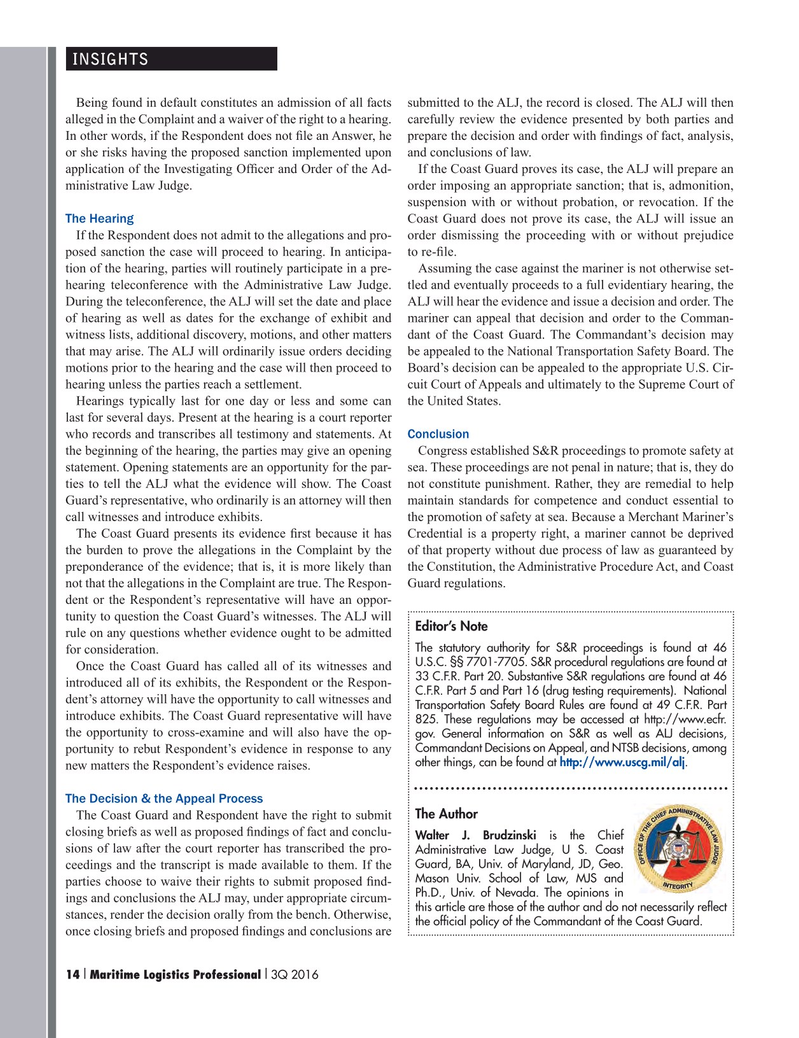
Page 14: of Maritime Logistics Professional Magazine (Q3 2016)
Shipbuilding, Repair & Maintenance
Read this page in Pdf, Flash or Html5 edition of Q3 2016 Maritime Logistics Professional Magazine
INSIGHTS
Being found in default constitutes an admission of all facts submitted to the ALJ, the record is closed. The ALJ will then alleged in the Complaint and a waiver of the right to a hearing. carefully review the evidence presented by both parties and
In other words, if the Respondent does not ? le an Answer, he prepare the decision and order with ? ndings of fact, analysis, or she risks having the proposed sanction implemented upon and conclusions of law. application of the Investigating Of? cer and Order of the Ad- If the Coast Guard proves its case, the ALJ will prepare an ministrative Law Judge. order imposing an appropriate sanction; that is, admonition, suspension with or without probation, or revocation. If the
The Hearing Coast Guard does not prove its case, the ALJ will issue an
If the Respondent does not admit to the allegations and pro- order dismissing the proceeding with or without prejudice posed sanction the case will proceed to hearing. In anticipa- to re-? le. tion of the hearing, parties will routinely participate in a pre- Assuming the case against the mariner is not otherwise set- hearing teleconference with the Administrative Law Judge. tled and eventually proceeds to a full evidentiary hearing, the
During the teleconference, the ALJ will set the date and place ALJ will hear the evidence and issue a decision and order. The of hearing as well as dates for the exchange of exhibit and mariner can appeal that decision and order to the Comman- witness lists, additional discovery, motions, and other matters dant of the Coast Guard. The Commandant’s decision may that may arise. The ALJ will ordinarily issue orders deciding be appealed to the National Transportation Safety Board. The motions prior to the hearing and the case will then proceed to Board’s decision can be appealed to the appropriate U.S. Cir- hearing unless the parties reach a settlement. cuit Court of Appeals and ultimately to the Supreme Court of
Hearings typically last for one day or less and some can the United States. last for several days. Present at the hearing is a court reporter who records and transcribes all testimony and statements. At Conclusion the beginning of the hearing, the parties may give an opening Congress established S&R proceedings to promote safety at statement. Opening statements are an opportunity for the par- sea. These proceedings are not penal in nature; that is, they do ties to tell the ALJ what the evidence will show. The Coast not constitute punishment. Rather, they are remedial to help
Guard’s representative, who ordinarily is an attorney will then maintain standards for competence and conduct essential to call witnesses and introduce exhibits. the promotion of safety at sea. Because a Merchant Mariner’s
The Coast Guard presents its evidence ? rst because it has Credential is a property right, a mariner cannot be deprived the burden to prove the allegations in the Complaint by the of that property without due process of law as guaranteed by preponderance of the evidence; that is, it is more likely than the Constitution, the Administrative Procedure Act, and Coast not that the allegations in the Complaint are true. The Respon- Guard regulations.
dent or the Respondent’s representative will have an oppor- tunity to question the Coast Guard’s witnesses. The ALJ will
Editor’s Note rule on any questions whether evidence ought to be admitted
The statutory authority for S&R proceedings is found at 46 for consideration.
U.S.C. §§ 7701-7705. S&R procedural regulations are found at
Once the Coast Guard has called all of its witnesses and 33 C.F.R. Part 20. Substantive S&R regulations are found at 46 introduced all of its exhibits, the Respondent or the Respon-
C.F.R. Part 5 and Part 16 (drug testing requirements). National dent’s attorney will have the opportunity to call witnesses and
Transportation Safety Board Rules are found at 49 C.F.R. Part introduce exhibits. The Coast Guard representative will have 825. These regulations may be accessed at http://www.ecfr.
the opportunity to cross-examine and will also have the op- gov. General information on S&R as well as ALJ decisions,
Commandant Decisions on Appeal, and NTSB decisions, among portunity to rebut Respondent’s evidence in response to any other things, can be found at http://www.uscg.mil/alj. new matters the Respondent’s evidence raises.
The Decision & the Appeal Process
The Coast Guard and Respondent have the right to submit The Author closing briefs as well as proposed ? ndings of fact and conclu-
Walter J. Brudzinski is the Chief sions of law after the court reporter has transcribed the pro-
Administrative Law Judge, U S. Coast
Guard, BA, Univ. of Maryland, JD, Geo. ceedings and the transcript is made available to them. If the
Mason Univ. School of Law, MJS and parties choose to waive their rights to submit proposed ? nd-
Ph.D., Univ. of Nevada. The opinions in ings and conclusions the ALJ may, under appropriate circum- this article are those of the author and do not necessarily re? ect stances, render the decision orally from the bench. Otherwise, the of? cial policy of the Commandant of the Coast Guard. once closing briefs and proposed ? ndings and conclusions are 14 Maritime Logistics Professional 3Q 2016
I I 1-17 Q3 MP2016.indd 14 8/17/2016 11:46:02 AM

 13
13

 15
15
